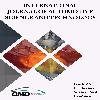Friction and Wear Properties of Automobile Brake Linings Containing Borax Powder with Different Grain Sizes
Borax which is an important boron compound, a mineral, and a salt of boric acid, is used as a fire retardant and insulating material. The most important reac-tion in automobile brake systems is heat generation from friction. The heat gen-erated at the interface of disc and lining may cause deformation of the materials forming the lining. Therefore, phenomena such as lining wear and brake fade may be occurred. The aim of this study is to reveal the positive effects of borax additive on lining and experimentally examine the effect of grain size of borax on tribological properties. Lining is produced by mixing more than one powder materials and pressing cold and hot. The size and homogeneous mixture of pow-der materials affect the braking performance. In this study, the effect of using nano and micro sized borax with the same content on the lining performance was investigated. The produced linings were tested on pin-on disc tester. Wear, hard-ness and density tests were performed. The change in the friction coefficient was observed due to the temperature increase. The friction coefficient of the nano-containing lining showed a more stable result depending on the temperature.
Keywords:
Borax Nano materials, Pad,
___
- Jeganmohan S, Sugozu B. Usage of powder pinus brutia cone and colemanite combination in brake friction composites as friction modifier. Mater Today-Proc. 2020; 27:2072-2075.
- Reinsch EW. Sintered metal brake linings for automotive appli-cations. In Perspectives in Powder Metallurgy Fundamentals, Methods, and Applications. Springer, Boston, MA. 1970; 9-21.
- Gediktaş M. Sürtünme malzemelerinin deneysel tayini, İstanbul Teknik Üniversitesi Matbaası, Gümüşsuyu, İstanbul. 1968.
- Sugözü İ. Bor Katkılı Asbetsiz Otomotiv Fren Balatası Üretimi ve Frenleme Karakteristiğinin İncelenmesi. Mech Eng. 2009;277.
- Başar G, Buldum BB, Sugözü İ. Kolemanit ve Boraks Takviyeli Fren Balatalarının Sürtünme Performansı. El-Cezeri J Sci Eng. 2018;5(2): 635-644.
- Sugözü I. Investigation of using rice husk dust and ulexite in automotive brake pads. Mater Test. 2015;57(10): 877-882.
- TSE 555. Highway Vehicles-Brake System-Brake Pads for Fric-tion Brake. Turkish Standard Institute. Ankara, Turkey. 1992.
- Ostermeyer GP. On the dynamics of the friction coefficient. Wear. 2003;254: 852-858.
- Anderson AE. Friction and Wear of Automotive Brakes, USA, Friction, Lubrication and Wear Technology ASM Handbook. 1992.
- Stachowiak GW, Batchelor AW. Adhesion and adhesive wear, In: Engineering Tribology, Eds, A.B.D: Butterworth-Heinemann, 2001;533-553.
- Persson BNJ. Theory of Friction - the Role of Elasticity in Boundary Lubrication. Phys Rev B, 1994;50 (7):4771-4786.
- Tabor D. Friction as a dissipated process, Friction of organic polymers in fundamentals of friction. Macroscopic and Microscopik Processes, 1996;3:220.
- Bijwe J, Aranganathan N, Sharma S, Dureja N, Kumar, R. Nano-abrasives in friction materials-influence on tribological properties. Wear. 2012;296:693-701.
- El-Tayeb NSM, Liew KW. On the dry and wet sliding performance of potentially new frictional brake pad materials for automotive industry. Wear. 2009;266:275–287.
- Eriksson M, Bergman F, Jacobson S. On the nature of tribological contact in automotive brakes. Wear. 2002;252:26–36.
- Sugozu B. Tribological properties of brake friction mate-rials containing fly ash. Ind Lubr Tribol. 2018;70: 902-906.
- Kim SJ, Jang H. Friction and wear of friction materials containing two different phenolic resins reinforced with aramid pulp. Tribol Int. 2000;33:477–484.
- Yayın Aralığı: Yılda 4 Sayı
- Başlangıç: 2016
- Yayıncı: Otomotiv Mühendisleri Derneği
Sayıdaki Diğer Makaleler
Şükran KATMER, Ulvi ŞEKER, Gökhan KÜÇÜKTÜRK, Hakan KÜÇÜKTÜRK, Çağlar YAVAŞ
Safiye Nur ÖZDEMİR, İmdat TAYMAZ
Modelling and simulation of detailed vehicle dynamics fordevelopment of innovative powertrains
Shantanu PARDHI, Ajinkya DESHMUKH, Hugo AJROUCHE
Yunus Emre EKİCİ, Teoman KARADAĞ, Mustafa NURMUHAMMED, İsmail Can DİKMEN
